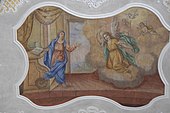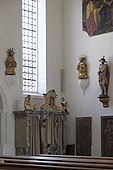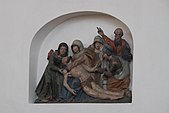St. Michael (Reichenkirchen)
The Roman Catholic parish church of St. Michael in Reichenkirchen , a district of the Fraunberg community in the Upper Bavarian district of Erding , is essentially a late Gothic building that was baroque in the second half of the 17th century and expanded in the middle of the 18th century. The church is richly decorated in the Rococo style . The patron saint of the church is the Archangel Michael .
history
As early as 1181, the Reichenkirchen parish was subject to the Freising Cathedral Chapter , which exercised the right of patronage . The parish church of St. Michael is mentioned for the first time in a document in the Konradinische Matrikel , the list of goods of the Diocese of Freising created in 1315/16 . When branches are Grafing , Lohkirchen and the lower village of Grucking called.
The late Gothic church was redesigned in the Baroque style from 1666 to 1690. In the years 1719/20, the Erdinger master builder Anton Kogler built a new tower and the sacristy . In 1753 the nave was extended by the master builder Johann Baptist Lethner, who is also based in Erding, and it is now designed in the Rococo style. In 1913/14 the choir was demolished and a transept and a new choir were built according to plans by the architect Franx Xaver Huf . During the interior restoration in 1960/61, the ceiling paintings that had been painted over in the 19th century were exposed again.
architecture
Exterior construction
The nave, the corners of which are rounded in the west, is structured by pilaster strips and high arched windows. The staircase to the pulpit is located in the round extension on the north side of the nave . The square bell tower rises on the south side in the corner between the nave and the transept. It is crowned with a curved hood and a lantern and is divided by profiled cornices . The bell storey has double pilasters on the edges .
The sundial on the south side of the tower dates from 1687. It was exposed again during the restoration in 1960/61.
inner space
The nave , a large hall space divided into five axes , is covered by a barrels of stab cap. The flat wall pillars are crowned by strong, multi-profiled entablature and reinforced by pilasters with Tuscan capitals . The semi-circular choir adjoins the three-axis transept in the east. The crossing is spanned by a flat hanging dome. The nave ceiling is covered with elegant stucco decor in the style of the Rococo, the ceiling images are framed by fine stucco frames. The same decor is also mimicked in the transept and choir. A double gallery forms the western end of the nave , the upper, curved parapet with rocailles motifs from the 1760s. A Marian monogram can be seen in the middle .
Ceiling paintings
The ceiling paintings in the nave were executed by Franz Joseph Aiglsdorfer in 1755/56. The central image shows the victory of Emperor Constantine the Great over his rival Maxentius in the battle of the Milvian Bridge in 312. Above the battle scene, the inscription "IN HOC SIGNO VINCES" (under this symbol you will win) can be read. On the eastern picture you can see the Annunciation , in the west, above the organ, Saint Elisabeth , who appears to Reichenkirchen pastor Michael Sullinger († 1644) in serious illness. In 1640, in gratitude for his recovery, the pastor founded the Elisabeth Brotherhood .
The representations on the northern vaults are dedicated to St. Elisabeth, those of the southern to St. Leonhard . The scenes of the four southern stabbing caps refer to Saint Nicholas of Tolentino . The scenes in the four northern needle caps have the Holy Cross as their theme; they remind us that a particle of the cross was once displayed on the high altar of the church for veneration. All pictures of the vault gussets and the stitch caps are provided with tape and inscriptions in German.
Furnishing
- The six-column high altar was made in 1756/59 by the carpenter Andreas Rauscher. The sculptures were created by the sculptor Christian Jorhan the Elder . To the side of the altar are St. Anne and St. Joachim , Mary's parents , and above the passages the apostles Simon with book and saw and Judas Thaddäus with club and book. The altarpiece from 1961 shows the Archangel Michael fighting against Lucifer .
- The two side altars from 1758 were also created by Andreas Rauscher and Christian Jorhan the Elder. The lateral figures of the north altar represent Saint Catherine with sword and wheel and Saint Cecilia with sword and portative . The Madonna figure in the central niche comes from the late Gothic period and is dated around 1490/1500. The southern side altar is dedicated to the cattle patron, St. Leonhard , who stands in the middle niche with book and chain in hand. To the side are the Roman martyrs and weather saints John and Paul .
- The pulpit from 1759 is accessible from the outside with its own staircase. On the pulpit the symbols of the evangelists are depicted with open Bibles, the colored reliefs show Jesus as the sower, the wonderful fishing and Jesus and the Samaritan woman. The sound cover is crowned with the Lamb of God .
- Across from the pulpit, in a niche in the south wall of the nave, is a wooden relief depicting the Lamentation of Christ from around 1510/20. It is attributed to the circle of the Landshut carver Hans Leinberger and still comes from the late Gothic church furnishings.
- In the transept, rococo busts by Christian Jorhan from around 1760 are placed on the walls.
- The confessional from 1765 in the north transept is also a work by Christian Jorhan.
- The figure of Ecce homo in the north transept is dated around 1700.
- The early Rococo style choir stalls were carved around 1735.
organ
The organ was built in 1899 by Franz Borgias Maerz . It has 12 registers on two manuals and a pedal . The disposition is:
|
|
|
|||||||||||||||||||||||||||||||||
- Coupling : II / I, II / P, I / P, super octave coupling I.
- Playing aids : piano, mezzoforte, tutti
- Remarks: cone chest , pneumatic game and stop action mechanism, free-standing game table
Epitaphs
Epitaphs from the 17th and 18th centuries are embedded in the walls of the north and south transepts . A red marble tombstone commemorates Pastor Michael Sullinger.
literature
- Georg Dehio : Handbook of German Art Monuments - Bavaria IV - Munich and Upper Bavaria . 2nd edition, Deutscher Kunstverlag , Munich 2002, ISBN 3-422-03010-7 , p. 1009.
- Sebastian Mayer: Parish of St. Michael Reichenkirchen . Peda-Kunstführer Nr. 152/2000, Kunstverlag Peda, Passau 2000, ISBN 3-89643-158-7 .
Web links
Individual evidence
Coordinates: 48 ° 21 ′ 32.7 " N , 11 ° 58 ′ 37.4" E















